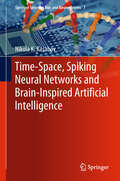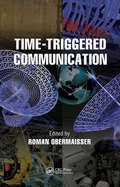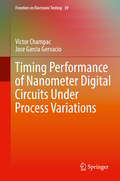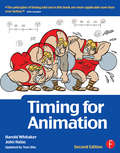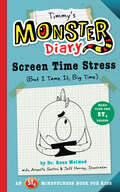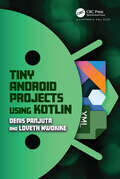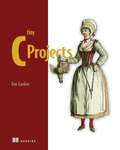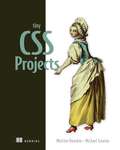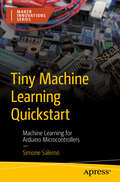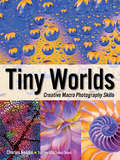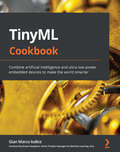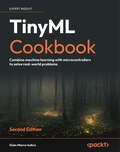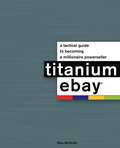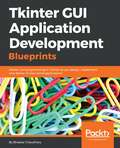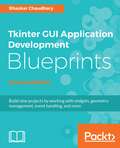- Table View
- List View
Time-Space, Spiking Neural Networks and Brain-Inspired Artificial Intelligence (Springer Series on Bio- and Neurosystems #7)
by Nikola K. KasabovSpiking neural networks (SNN) are biologically inspired computational models that represent and process information internally as trains of spikes. This monograph book presents the classical theory and applications of SNN, including original author’s contribution to the area. The book introduces for the first time not only deep learning and deep knowledge representation in the human brain and in brain-inspired SNN, but takes that further to develop new types of AI systems, called in the book brain-inspired AI (BI-AI). BI-AI systems are illustrated on: cognitive brain data, including EEG, fMRI and DTI; audio-visual data; brain-computer interfaces; personalized modelling in bio-neuroinformatics; multisensory streaming data modelling in finance, environment and ecology; data compression; neuromorphic hardware implementation. Future directions, such as the integration of multiple modalities, such as quantum-, molecular- and brain information processing, is presented in the last chapter. The book is a research book for postgraduate students, researchers and practitioners across wider areas, including computer and information sciences, engineering, applied mathematics, bio- and neurosciences.
Time-Triggered Communication (Embedded Systems)
by Roman ObermaisserTime-Triggered Communication helps readers build an understanding of the conceptual foundation, operation, and application of time-triggered communication, which is widely used for embedded systems in a diverse range of industries. This book assembles contributions from experts that examine the differences and commonalities of the most significant protocols including: TTP, FlexRay, TTEthernet, SAFEbus, TTCAN, and LIN. Covering the spectrum, from low-cost time-triggered fieldbus networks to ultra-reliable time-triggered networks used for safety-critical applications, the authors illustrate the inherent benefits of time-triggered communication in terms of predictability, complexity management, fault-tolerance, and analytical dependability modeling, which are key aspects of safety-critical systems. Examples covered include FlexRay in cars, TTP in railway and avionic systems, and TTEthernet in aerospace applications. Illustrating key concepts based on real-world industrial applications, this book: Details the underlying concepts and principles of time-triggered communication Explores the properties of a time-triggered communication system, contrasting its strengths and weaknesses Focuses on the core algorithms applied in many systems, including those used for clock synchronization, startup, membership, and fault isolation Describes the protocols that incorporate presented algorithms Covers tooling requirements and solutions for system integration, including scheduling The information in this book is extremely useful to industry leaders who design and manufacture products with distributed embedded systems based on time-triggered communication. It also benefits suppliers of embedded components or development tools used in this area. As an educational tool, this material can be used to teach students and working professionals in areas including embedded systems, computer networks, system architectures, dependability, real-time systems, and automotive, avionics, and industrial control systems.
Time-dependent Problems in Imaging and Parameter Identification
by Thomas Schuster Barbara Kaltenbacher Anne WaldInverse problems such as imaging or parameter identification deal with the recovery of unknown quantities from indirect observations, connected via a model describing the underlying context. While traditionally inverse problems are formulated and investigated in a static setting, we observe a significant increase of interest in time-dependence in a growing number of important applications over the last few years. Here, time-dependence affects a) the unknown function to be recovered and / or b) the observed data and / or c) the underlying process. Challenging applications in the field of imaging and parameter identification are techniques such as photoacoustic tomography, elastography, dynamic computerized or emission tomography, dynamic magnetic resonance imaging, super-resolution in image sequences and videos, health monitoring of elastic structures, optical flow problems or magnetic particle imaging to name only a few. Such problems demand for innovation concerning their mathematical description and analysis as well as computational approaches for their solution.
Time-of-Flight and Structured Light Depth Cameras
by Pietro Zanuttigh Giulio Marin Carlo Dal Mutto Fabio Dominio Ludovico Minto Guido Maria CortelazzoThis book provides a comprehensive overview of the key technologies and applications related to new cameras that have brought 3D data acquisition to the mass market. It covers both the theoretical principles behind the acquisition devices and the practical implementation aspects of the computer vision algorithms needed for the various applications. Real data examples are used in order to show the performances of the various algorithms. The performance and limitations of the depth camera technology are explored, along with an extensive review of the most effective methods for addressing challenges in common applications. Applications covered in specific detail include scene segmentation, 3D scene reconstruction, human pose estimation and tracking and gesture recognition. This book offers students, practitioners and researchers the tools necessary to explore the potential uses of depth data in light of the expanding number of devices available for sale. It explores the impact of these devices on the rapidly growing field of depth-based computer vision.
Timing Jitter in Time-of-Flight Range Imaging Cameras
by Gehan AnthonysThis book explains how depth measurements from the Time-of-Flight (ToF) range imaging cameras are influenced by the electronic timing-jitter. The author presents jitter extraction and measurement techniques for any type of ToF range imaging cameras. The author mainly focuses on ToF cameras that are based on the amplitude modulated continuous wave (AMCW) lidar techniques that measure the phase difference between the emitted and reflected light signals. The book discusses timing-jitter in the emitted light signal, which is sensible since the light signal of the camera is relatively straightforward to access. The specific types of jitter that present on the light source signal are investigated throughout the book. The book is structured across three main sections: a brief literature review, jitter measurement, and jitter influence in AMCW ToF range imaging.
Timing Performance of Nanometer Digital Circuits Under Process Variations (Frontiers In Electronic Testing Ser. #39)
by Victor Champac Jose Garcia GervacioThis book discusses the digital design of integrated circuits under process variations, with a focus on design-time solutions. The authors describe a step-by-step methodology, going from logic gates to logic paths to the circuit level. Topics are presented in comprehensively, without overwhelming use of analytical formulations. Emphasis is placed on providing digital designers with understanding of the sources of process variations, their impact on circuit performance and tools for improving their designs to comply with product specifications. Various circuit-level “design hints” are highlighted, so that readers can use then to improve their designs. A special treatment is devoted to unique design issues and the impact of process variations on the performance of FinFET based circuits. This book enables readers to make optimal decisions at design time, toward more efficient circuits, with better yield and higher reliability.
Timing for Animation
by Tom SitoThe classic work on animation principles, now fully updated for the digital age.
Timing for Animation, 40th Anniversary Edition
by Harold Whitaker John HalasTiming for Animation has been one of the pillars of animation since it was first published in 1981. Now this 40th anniversary edition captures the focus of the original and enhances this new edition with fresh images, techniques, and advice from world-renowned animators. Not only does the text explore timing in traditional animation, but also timing in digital works. Vibrant illustrations and clear directions line the pages to help depict the various methods and procedures to bring your animation to life. Examples include timing for digital production, digital storyboarding in 2D, digital storyboarding in 3D, and the use of After Effects, as well as interactive games, television, animals, and more. Learn how animated scenes should be arranged in relation to each other, how much space should be used, and how long each drawing should be shown for maximum dramatic effect. All you need to breathe life into your animation is at your fingertips with Timing for Animation. Key Features: Fully revised and updated with modern examples and techniques Explores the fundamentals of timing, physics, and animation Perfect for the animation novice and the expert Get straight to the good stuff with simple, no-nonsense instruction on the key techniques like stretch and squash, animated cycles, overlapping, and anticipation. Trying to time weight, mood, and power can make or break an animation—get it right the first time with these tried and tested techniques. Authors Harold Whitaker was a BAFTA-nominated professional animator and educator for 40 years; many of his students number among today’s most outstanding animation artists. John Halas, known as "The father of British animation" and formerly of Halas & Batchelor Animation Studio, produced more than 2,000 animation films, including the legendary Animal Farm (1954) and the award-winning Dilemma (1981). He was also the founder and president of the International Animated Film Association (ASIFA) and former Chairman of the British Federation of Film Societies. Tom Sito is Professor of Animation at the University of Southern California and has written numerous books and articles on animation. Tom’s screen credits include Shrek (2001) and the Disney classics Who Framed Roger Rabbit (1988), The Little Mermaid (1989), Beauty and the Beast (1991), Aladdin (1992), and The Lion King (1994). In 1998, Tom was named by Animation Magazine as one of the 100 Most Important People in Animation.
Timmy's Monster Diary: Screen Time Stress (But I Tame It, Big Time) (Monster Diaries #2)
by Raun Melmed Annette SextonMeet Timmy, a lovable monster who can’t get enough of the coolest gadgets and video games. Too bad he doesn’t realize how much time he spends each day in front of a screen. In the same humorous spirit of Diary of a Wimpy Kid comes Timmy’s Monster Diary: Screen Time Stress. Using the “Time-Telling” and “ST4” techniques developed by Dr. Raun Melmed of the Melmed Center in Arizona, Timmy’s Monster Diary teaches kids how to self-monitor the amount of time they spend on technology. Timmy’s hilarious doodles and diary entries chronicle his delightful adventures, misadventures, and eventual triumph in a funny, relatable way. It’s the one book that kids will want to turn off the TV and read! Timmy’s Monster Diary also includes a resource section to help parents and teachers implement Dr. Melmed’s methods, plus ST4 reminders that kids can remove, color, and place around the house. Ages 6–12 Don’t miss Marvin’s ADHD adventures in Book 1.
Tiny Android Projects Using Kotlin
by Denis Panjuta Loveth NwokikeIn today’s fast-paced world, Android development is a rapidly evolving field that requires regular updates to keep up with the latest trends and technologies. Tiny Android Projects Using Kotlin is an excellent resource for developers who want to learn to build Android applications using the latest tools and frameworks. KEY FEATURES • Teaches building Android apps using Kotlin, XML, and Jetpack Compose • Includes saving data on the device using the Room database library • Teaches communication between an Android device and data on the internet using REST API • Shows how to create different Android menu navigations using Jetpack Compose • Introduces the most architectures used in Android Projects and implements MVVM With Kotlin being the most preferred language for Android development, this book provides a practical, hands-on approach to learning the language and building high-quality Android apps using Kotlin, XML, and Jetpack Compose.
Tiny C Projects
by Dan GookinLearn the big skills of C programming by creating bite-size projects! Work your way through these 15 fun and interesting tiny challenges to master essential C techniques you&’ll use in full-size applications.In Tiny C Projects you will learn how to: Create libraries of functions for handy use and re-use Process input through an I/O filter to generate customized output Use recursion to explore a directory tree and find duplicate files Develop AI for playing simple games Explore programming capabilities beyond the standard C library functions Evaluate and grow the potential of your programs Improve code to better serve users Tiny C Projects is an engaging collection of 15 small programming challenges! This fun read develops your C abilities with lighthearted games like tic-tac-toe, utilities like a useful calendar, and thought-provoking exercises like encoding and cyphers. Jokes and lighthearted humor make even complex ideas fun to learn. Each project is small enough to complete in a weekend, and encourages you to evolve your code, add new functions, and explore the full capabilities of C. About the technology The best way to gain programming skills is through hands-on projects—this book offers 15 of them. C is required knowledge for systems engineers, game developers, and roboticists, and you can start writing your own C programs today. Carefully selected projects cover all the core coding skills, including storing and modifying text, reading and writing files, searching your computer&’s directory system, and much more. About the book Tiny C Projects teaches C gradually, from project to project. Covering a variety of interesting cases, from timesaving tools, simple games, directory utilities, and more, each program you write starts out simple and gets more interesting as you add features. Watch your tiny projects grow into real applications and improve your C skills, step by step. What's inside Caesar cipher solver: Use an I/O filter to generate customized output Duplicate file finder: Use recursion to explore a directory tree Daily greetings: Writing the moon phase algorithm Lotto pics: Working with random numbers And 11 more fun projects! About the reader For C programmers of all skill levels. About the author Dan Gookin has over 30 years of experience writing about complex topics. His most famous work is DOS For Dummies, which established the entire For Dummies brand. Table of Contents 1 Configuration and setup 2 Daily greetings 3 NATO output 4 Caesarean cipher 5 Encoding and decoding 6 Password generators 7 String utilities 8 Unicode and wide characters 9 Hex dumper 10 Directory tree 11 File finder 12 Holiday detector 13 Calendar 14 Lotto picks 15 Tic-tac-toe
Tiny CSS Projects
by Martine Dowden Michael GearonCSS is a must-know language for all web developers. In this practical book, you&’ll explore numerous techniques to improve the way you write CSS as you build 12 tiny projects.In Tiny CSS Projects you&’ll build twelve exciting and useful web projects including: A loading screen created by styling SVG graphics A responsive newspaper layout with multiple columns Animating social media buttons with pseudo-elements Designing layouts using CSS grids Summary cards that utilize hover interactions Styling forms to make them more appealing to your users The projects may be tiny, but the CSS skills you&’ll learn are huge! Tiny CSS Projects teaches you how to make beautiful websites and applications by guiding you through a dozen fun coding challenges. You&’ll learn important skills through hands-on practice as you tinker with your own code and make real creative decisions about the projects you&’re building. You&’ll rapidly master the basics and then press on into CSS&’s exciting layout features including grid and flexbox, animations, transitions, and media queries. About the Technology Don&’t settle for boring web pages! With Cascading Style Sheets you can control color, layout, and typography to make your sites both functional and beautiful. CSS is a essential skill for web developers and designers. This book will help you get started the right way. About the Book Tiny CSS Projects builds your CSS skills by guiding you through 12 creative mini-projects. Each interesting challenge starts with a downloadable HTML skeleton. As you flesh it out with your own design ideas, you&’ll master CSS concepts like transitions, layout, and styling forms, and explore powerful features including Flexbox and Grid. All the skills you&’ll learn are easy to transfer to full-size applications. When you finish, you&’ll have an exciting portfolio of designs ready to go for your next project. What's Inside Transitions and animations using keyframes Layout techniques including Grid and Flexbox Styling form elements including radio buttons Embedding fonts and typography-related styles Conditional styling using pseudo-elements and media queries About the reader For readers who know the basics of HTML and frontend development. No previous experience with CSS is required. About the author Martine Dowden is an author, speaker, and award-winning CTO. Michael Gearon is a user experience designer and frontend developer who has worked with many well-known brands. Table of Contents 1 CSS introduction 2 Designing a layout using CSS Grid 3 Creating a responsive animated loading screen 4 Creating a responsive web newspaper layout 5 Summary cards with hover interactions 6 Creating a profile card 7 Harnessing the full power of float 8 Designing a checkout cart 9 Creating a virtual credit card 10 Styling forms 11 Animated social media share links 12 Using preprocessors
Tiny Machine Learning Quickstart: Machine Learning for Arduino Microcontrollers (Maker Innovations Series)
by Simone SalernoBe a part of the Tiny Machine Learning (TinyML) revolution in the ever-growing world of IoT. This book examines the concepts, workflows, and tools needed to make your projects smarter, all within the Arduino platform. You’ll start by exploring Machine learning in the context of embedded, resource-constrained devices as opposed to your powerful, gigabyte-RAM computer. You’ll review the unique challenges it poses, but also the limitless possibilities it opens. Next, you’ll work through nine projects that encompass different data types (tabular, time series, audio and images) and tasks (classification and regression). Each project comes with tips and tricks to collect, load, plot and analyse each type of data. Throughout the book, you’ll apply three different approaches to TinyML: traditional algorithms (Decision Tree, Logistic Regression, SVM), Edge Impulse (a no-code online tools), and TensorFlow for Microcontrollers. Each has its strengths and weaknesses, and you will learn how to choose the most appropriate for your use case. TinyML Quickstart will provide a solid reference for all your future projects with minimal cost and effort. What You Will Learn Navigate embedded ML challenges Integrate Python with Arduino for seamless data processing Implement ML algorithms Harness the power of Tensorflow for artificial neural networks Leverage no-code tools like Edge Impulse Execute real-world projects Who This Book Is For Electronics hobbyists and developers with a basic understanding of Tensorflow, ML in Python, and Arduino-based programming looking to apply that knowledge with microcontrollers. Previous experience with C++ is helpful but not required.
Tiny Python Projects: Learn coding and testing with puzzles and games
by Ken Youens-Clark&”Tiny Python Projects is a gentle and amusing introduction to Python that will firm up key programming concepts while also making you giggle.&”—Amanda Debler, Schaeffler Key Features Learn new programming concepts through 21-bitesize programs Build an insult generator, a Tic-Tac-Toe AI, a talk-like-a-pirate program, and more Discover testing techniques that will make you a better programmer Code-along with free accompanying videos on YouTube Purchase of the print book includes a free eBook in PDF, Kindle, and ePub formats from Manning Publications.About The Book The 21 fun-but-powerful activities in Tiny Python Projects teach Python fundamentals through puzzles and games. You&’ll be engaged and entertained with every exercise, as you learn about text manipulation, basic algorithms, and lists and dictionaries, and other foundational programming skills. Gain confidence and experience while you create each satisfying project. Instead of going quickly through a wide range of concepts, this book concentrates on the most useful skills, like text manipulation, data structures, collections, and program logic with projects that include a password creator, a word rhymer, and a Shakespearean insult generator. Author Ken Youens-Clark also teaches you good programming practice, including writing tests for your code as you go. What You Will Learn Write command-line Python programs Manipulate Python data structures Use and control randomness Write and run tests for programs and functions Download testing suites for each project This Book Is Written For For readers familiar with the basics of Python programming. About The Author Ken Youens-Clark is a Senior Scientific Programmer at the University of Arizona. He has an MS in Biosystems Engineering and has been programming for over 20 years. Table of Contents 1 How to write and test a Python program 2 The crow&’s nest: Working with strings 3 Going on a picnic: Working with lists 4 Jump the Five: Working with dictionaries 5 Howler: Working with files and STDOUT 6 Words count: Reading files and STDIN, iterating lists, formatting strings 7 Gashlycrumb: Looking items up in a dictionary 8 Apples and Bananas: Find and replace 9 Dial-a-Curse: Generating random insults from lists of words 10 Telephone: Randomly mutating strings 11 Bottles of Beer Song: Writing and testing functions 12 Ransom: Randomly capitalizing text 13 Twelve Days of Christmas: Algorithm design 14 Rhymer: Using regular expressions to create rhyming words 15 The Kentucky Friar: More regular expressions 16 The Scrambler: Randomly reordering the middles of words 17 Mad Libs: Using regular expressions 18 Gematria: Numeric encoding of text using ASCII values 19 Workout of the Day: Parsing CSV files, creating text table output 20 Password strength: Generating a secure and memorable password 21 Tic-Tac-Toe: Exploring state 22 Tic-Tac-Toe redux: An interactive version with type hints
Tiny Worlds
by Charles NeedleSuccessful nature photographer and lecturer Charles Needle often asks students in his workshops if they understand the difference between "looking" and "seeing". The difference he is pointing out is that while we are constantly "looking" at countless people, places and things, we might not be actually seeing what is right in front of us. Being tuned into this difference can elevate your art as a photographer, allowing you to be more in tune with your surroundings. Needle has applied this concept to his work and it shows. Utilizing macro photography to capture the nuances of the nature all around us. In this extensive handbook, Needle covers not only his philosophy for seeing and capturing nature photography but delves into the equipment he uses. Needle covers composition, flash techniques, the fundamentals of macro photography and so much more. The book features many set-up shots, equipment shots and sequential shots detailing the progression towards creating the final images. This essential text provides both the inspiration and the technique required to beautifully capture the wonders of nature.
TinyML Cookbook: Combine artificial intelligence and ultra-low-power embedded devices to make the world smarter
by Gian Marco Iodice Ronan NaughtonWork through over 50 recipes to develop smart applications on Arduino Nano 33 BLE Sense and Raspberry Pi Pico using the power of machine learningKey FeaturesTrain and deploy ML models on Arduino Nano 33 BLE Sense and Raspberry Pi PicoWork with different ML frameworks such as TensorFlow Lite for Microcontrollers and Edge ImpulseExplore cutting-edge technologies such as microTVM and Arm Ethos-U55 microNPUBook DescriptionThis book explores TinyML, a fast-growing field at the unique intersection of machine learning and embedded systems to make AI ubiquitous with extremely low-powered devices such as microcontrollers. The TinyML Cookbook starts with a practical introduction to this multidisciplinary field to get you up to speed with some of the fundamentals for deploying intelligent applications on Arduino Nano 33 BLE Sense and Raspberry Pi Pico. As you progress, you'll tackle various problems that you may encounter while prototyping microcontrollers, such as controlling the LED state with GPIO and a push-button, supplying power to microcontrollers with batteries, and more. Next, you'll cover recipes relating to temperature, humidity, and the three “V” sensors (Voice, Vision, and Vibration) to gain the necessary skills to implement end-to-end smart applications in different scenarios. Later, you'll learn best practices for building tiny models for memory-constrained microcontrollers. Finally, you'll explore two of the most recent technologies, microTVM and microNPU that will help you step up your TinyML game. By the end of this book, you'll be well-versed with best practices and machine learning frameworks to develop ML apps easily on microcontrollers and have a clear understanding of the key aspects to consider during the development phase.What you will learnUnderstand the relevant microcontroller programming fundamentalsWork with real-world sensors such as the microphone, camera, and accelerometerRun on-device machine learning with TensorFlow Lite for MicrocontrollersImplement an app that responds to human voice with Edge ImpulseLeverage transfer learning to classify indoor rooms with Arduino Nano 33 BLE SenseCreate a gesture-recognition app with Raspberry Pi PicoDesign a CIFAR-10 model for memory-constrained microcontrollersRun an image classifier on a virtual Arm Ethos-U55 microNPU with microTVMWho this book is forThis book is for machine learning developers/engineers interested in developing machine learning applications on microcontrollers through practical examples quickly. Basic familiarity with C/C++, the Python programming language, and the command-line interface (CLI) is required. However, no prior knowledge of microcontrollers is necessary.
TinyML Cookbook: Combine machine learning with microcontrollers to solve real-world problems
by Gian Marco IodiceOver 70 recipes to help you develop smart applications on Arduino Nano 33 BLE Sense, Raspberry Pi Pico, and SparkFun RedBoard Artemis Nano using the power of machine learning Purchase of the print or Kindle book includes a free eBook in PDF format.Key FeaturesOver 20+ new recipes, including recognizing music genres and detecting objects in a sceneCreate practical examples using TensorFlow Lite for Microcontrollers, Edge Impulse, and moreExplore cutting-edge technologies, such as on-device training for updating models without data leaving the deviceBook DescriptionDiscover the incredible world of tiny Machine Learning (tinyML) and create smart projects using real-world data sensors with the Arduino Nano 33 BLE Sense, Raspberry Pi Pico, and SparkFun RedBoard Artemis Nano. TinyML Cookbook, Second Edition, will show you how to build unique end-to-end ML applications using temperature, humidity, vision, audio, and accelerometer sensors in different scenarios. These projects will equip you with the knowledge and skills to bring intelligence to microcontrollers. You'll train custom models from weather prediction to real-time speech recognition using TensorFlow and Edge Impulse.Expert tips will help you squeeze ML models into tight memory budgets and accelerate performance using CMSIS-DSP. This improved edition includes new recipes featuring an LSTM neural network to recognize music genres and the Faster-Objects-More-Objects (FOMO) algorithm for detecting objects in a scene. Furthermore, you’ll work on scikit-learn model deployment on microcontrollers, implement on-device training, and deploy a model using microTVM, including on a microNPU. This beginner-friendly and comprehensive book will help you stay up to date with the latest developments in the tinyML community and give you the knowledge to build unique projects with microcontrollers!What you will learnUnderstand the microcontroller programming fundamentalsWork with real-world sensors, such as the microphone, camera, and accelerometerImplement an app that responds to human voice or recognizes music genresLeverage transfer learning with FOMO and KerasLearn best practices on how to use the CMSIS-DSP libraryCreate a gesture-recognition app to build a remote controlDesign a CIFAR-10 model for memory-constrained microcontrollersTrain a neural network on microcontrollersWho this book is forThis book is ideal for machine learning engineers or data scientists looking to build embedded/edge ML applications and IoT developers who want to add machine learning capabilities to their devices. If you’re an engineer, student, or hobbyist interested in exploring tinyML, then this book is your perfect companion. Basic familiarity with C/C++ and Python programming is a prerequisite; however, no prior knowledge of microcontrollers is necessary to get started with this book.
TinyML: Machine Learning with TensorFlow Lite on Arduino and Ultra-Low-Power Microcontrollers
by Pete Warden Daniel SitunayakeDeep learning networks are getting smaller. Much smaller. The Google Assistant team can detect words with a model just 14 kilobytes in size—small enough to run on a microcontroller. With this practical book you’ll enter the field of TinyML, where deep learning and embedded systems combine to make astounding things possible with tiny devices.Pete Warden and Daniel Situnayake explain how you can train models small enough to fit into any environment. Ideal for software and hardware developers who want to build embedded systems using machine learning, this guide walks you through creating a series of TinyML projects, step-by-step. No machine learning or microcontroller experience is necessary.Build a speech recognizer, a camera that detects people, and a magic wand that responds to gesturesWork with Arduino and ultra-low-power microcontrollersLearn the essentials of ML and how to train your own modelsTrain models to understand audio, image, and accelerometer dataExplore TensorFlow Lite for Microcontrollers, Google’s toolkit for TinyMLDebug applications and provide safeguards for privacy and securityOptimize latency, energy usage, and model and binary size
Titanium Ebay, 2nd Edition: A Tactical Guide to Becoming a Millionaire Powerseller
by Skip McGrathHow to make it to the online big time! Titanium eBay® is for everyone who aspires to reach the highest level of success within eBay®, whether they've been selling for years or whether they're just starting out but have ambitious plans for their business. With 60 chapters that leave no stone unturned, this is truly the business bible for eBay® PowerSellers. • eBay® ended 2007 with over $8.7 billion in gross merchandise sales • There are 212 million global registered eBay® users operating across 23 international eBay® sites—twice as many as in 2004 • There are approximately 720,000 PowerSellers on eBay® who make a living selling merchandise through eBay®.
Titanium eBay: A Tactical Guide to Becoming a Millionaire Powerseller
by Skip McgrathWhether you're an experienced PowerSeller looking to take your business to the highest level, or just starting out and wanting to avoid a novice's missteps and dead ends, Titanium eBay offers you a clear path to success.
Tizen Cookbook
by Leon AnaviIf you want to enter the fascinating world of Tizen and learn how to develop engaging and successful applications then this book is for you. It'll benefit novices and experienced application developers alike.
Tkinter GUI Application Development Blueprints
by Bhaskar ChaudharyMaster GUI programming in Tkinter as you design, implement, and deliver ten real-world applications from start to finish About This Book * Conceptualize and build state-of-art GUI applications with Tkinter * Tackle the complexity of just about any size GUI application with a structured and scalable approach * A project-based, practical guide to get hands-on into Tkinter GUI development Who This Book Is For Software developers, scientists, researchers, engineers, students, or programming hobbyists with basic familiarity in Python will find this book interesting and informative. People familiar with basic programming constructs in other programming language can also catch up with some brief reading on Python. No GUI programming experience is expected. What You Will Learn * Get to know the basic concepts of GUI programming, such as Tkinter top-level widgets, geometry management, event handling, using callbacks, custom styling, and dialogs * Create apps that can be scaled in size or complexity without breaking down the core * Write your own GUI framework for maximum code reuse * Build apps using both procedural and OOP styles, understanding the strengths and limitations of both styles * Learn to structure and build large GUI applications based on Model-View-Controller (MVC) architecture * Build multithreaded and database-driven apps * Create apps that leverage resources from the network * Learn basics of 2D and 3D animation in GUI applications * Develop apps that can persist application data with object serialization and tools such as configparser In Detail Tkinter is the built-in GUI package that comes with standard Python distributions. It is a cross-platform package, which means you build once and deploy everywhere. It is simple to use and intuitive in nature, making it suitable for programmers and non-programmers alike. This book will help you master the art of GUI programming. It delivers the bigger picture of GUI programming by building real-world, productive, and fun applications such as a text editor, drum machine, game of chess, media player, drawing application, chat application, screen saver, port scanner, and many more. In every project, you will build on the skills acquired in the previous project and gain more expertise. You will learn to write multithreaded programs, network programs, database driven programs and more. You will also get to know the modern best practices involved in writing GUI apps. With its rich source of sample code, you can build upon the knowledge gained with this book and use it in your own projects in the discipline of your choice. Style and approach An easy-to-follow guide, full of hands-on examples of real-world GUI programs. The first chapter is a must read as it explains most of the things you need to get started with writing GUI programs with Tkinter. Each subsequent chapter is a stand-alone project that discusses some aspects of GUI programming in detail. These chapters can be read sequentially or randomly depending upon the readers experience with Python.
Tkinter GUI Application Development Blueprints
by Bhaskar ChaudharyGeometry Management, Event Handling, and more Key Features A Practical, guide to learn the application of Python and GUI programming with tkinter Create multiple cross-platform real-world projects by integrating host of third party libraries and tools Learn to build beautiful and highly interactive user interfaces, targeting multiple devices. Book Description Tkinter is the built-in GUI package that comes with standard Python distributions. It is a cross-platform package, which means you build once and deploy everywhere. It is simple to use and intuitive in nature, making it suitable for programmers and non-programmers alike. This book will help you master the art of GUI programming. It delivers the bigger picture of GUI programming by building real-world, productive, and fun applications such as a text editor, drum machine, game of chess, audio player, drawing application, piano tutor, chat application, screen saver, port scanner, and much more. In every project, you will build on the skills acquired in the previous project and gain more expertise. You will learn to write multithreaded programs, network programs, database-driven programs, asyncio based programming and more. You will also get to know the modern best practices involved in writing GUI apps. With its rich source of sample code, you can build upon the knowledge gained with this book and use it in your own projects in the discipline of your choice. What you will learn -A Practical, guide to help you learn the application of Python and GUI programming with Tkinter - Create multiple, cross-platform, real-world projects by integrating a host of third-party libraries and tools - Learn to build beautiful and highly interactive user interfaces, targeting multiple devices. Who this book is for This book is for a beginner to intermediate-level Pythonists who want to build modern, cross-platform GUI applications with the amazingly powerful Tkinter. Prior knowledge of Tkinter is required.
Tkinter GUI Application Development Blueprints, Second Edition: Build Nine Projects By Working With Widgets, Geometry Management, Event Handling, And More, 2nd Edition
by Bhaskar ChaudharyTkinter is the built-in GUI package that comes with standard Python distributions. It is a cross-platform package, which means you build once and deploy everywhere. It is simple to use and intuitive in nature, making it suitable for learners. This book will enable you to use Tkinter effectively through working on nine versatile projects.
Tkinter GUI Application Development Blueprints, Second Edition: Build nine projects by working with widgets, geometry management, event handling, and more, 2nd Edition
by Bhaskar Chaudhary Erik S. RapertGeometry Management, Event Handling, and moreKey FeaturesA Practical, guide to learn the application of Python and GUI programming with tkinterCreate multiple cross-platform real-world projects by integrating host of third party libraries and toolsLearn to build beautiful and highly interactive user interfaces, targeting multiple devices.Book DescriptionTkinter is the built-in GUI package that comes with standard Python distributions. It is a cross-platform package, which means you build once and deploy everywhere. It is simple to use and intuitive in nature, making it suitable for programmers and non-programmers alike.This book will help you master the art of GUI programming. It delivers the bigger picture of GUI programming by building real-world, productive, and fun applications such as a text editor, drum machine, game of chess, audio player, drawing application, piano tutor, chat application, screen saver, port scanner, and much more. In every project, you will build on the skills acquired in the previous project and gain more expertise. You will learn to write multithreaded programs, network programs, database-driven programs, asyncio based programming and more. You will also get to know the modern best practices involved in writing GUI apps. With its rich source of sample code, you can build upon the knowledge gained with this book and use it in your own projects in the discipline of your choice.What you will learn-A Practical, guide to help you learn the application of Python and GUI programming with Tkinter- Create multiple, cross-platform, real-world projects by integrating a host of third-party libraries and tools- Learn to build beautiful and highly interactive user interfaces, targeting multiple devices.Who this book is forThis book is for a beginner to intermediate-level Pythonists who want to build modern, cross-platform GUI applications with the amazingly powerful Tkinter. Prior knowledge of Tkinter is required.
